Survey and Research Report
on the
Woodlawn Bungalow
1015 West Fourth Street, Charlotte
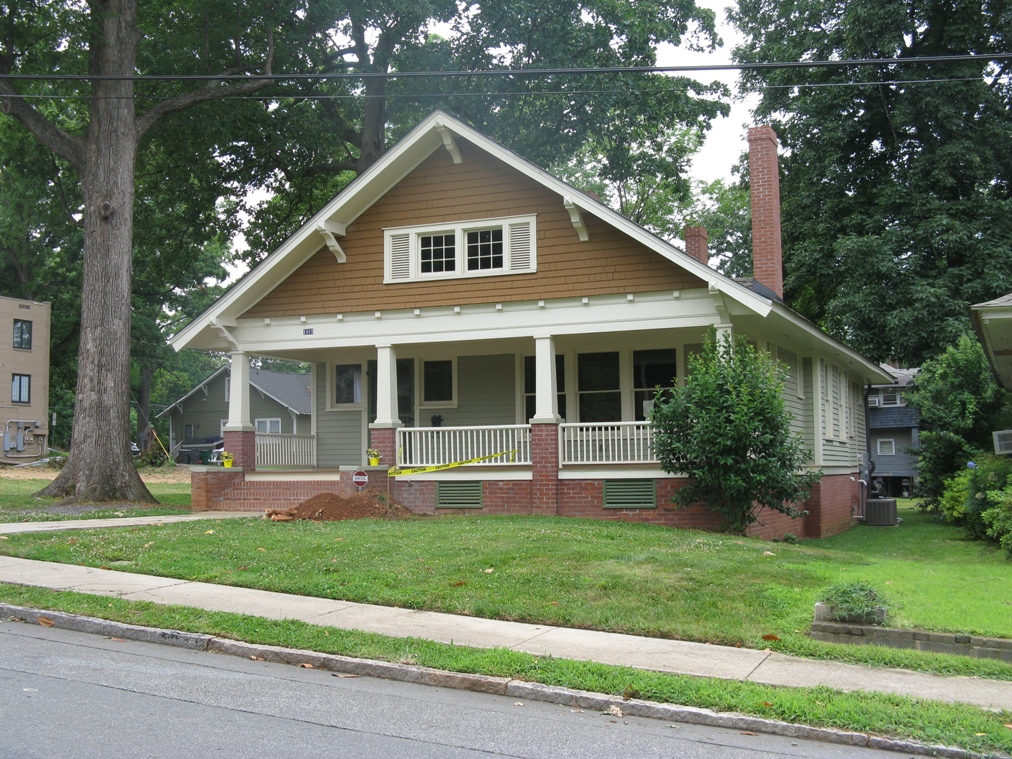
1. Name and location of the property: The property known as the Woodlawn Bungalow is located at 1015 West Fourth Street, Charlotte, North Carolina.
2. Name and address of the current owner of the property:
The Committee to Restore and Preserve Third Ward
1001 West First Street
Charlotte, NC
3. Representative photographs of the property. This report contains representative photographs of the property
4. A map depicting the location of the property.
Mecklenburg County Tax Map

5. Current Deed Book Reference To The Property. The most recent deed to this property is found in Mecklenburg County Deed Book 9443, page 998. The tax parcel number for the property is 07321513.
6. A Brief Historical Essay On The Property. This report contains a brief historical sketch of the property prepared by William Jeffers.
7. A Brief Physical Description Of The Property. This report contains a brief physical description of the property prepared by Stewart Gray.
8. Documentation of why and in what ways the property meets the criteria for designation set forth in N.C.G.S. 160A-400.5.
a. Special significance in terms of its history, architecture, and/or cultural importance. The Charlotte-Mecklenburg Historic Landmarks Commission judges that 1015 West Fourth Street possesses special significance in terms of Charlotte-Mecklenburg. The Commission bases its judgment on the following considerations:
1) The Woodlawn Bungalow is a remarkably well preserved example of a Craftsman Style bungalow, typical of the type of house that was constructed for middle class residents of Charlotte in the city’s urban core for a brief period of time in the early 1900s.
2) The Woodlawn Bungalow may very well contain the most complete and best preserved Craftsman Style bungalow interior in the City of Charlotte.
3) The Woodlawn Bungalow is an important element of Woodlawn, an early streetcar suburb, and is a reminder of the early 20th century residential nature of Charlotte’s urban core
b. Integrity of design, setting, workmanship, materials, feeling and/or association: The Commission judges that the physical description included in this report demonstrates that the property known as The Woodlawn Bungalow meets this criterion.
9. Ad Valorem Tax Appraisal: The Commission is aware that designation would allow the owner to apply for automatic deferral of 50% of the Ad Valorem taxes on all or any portion of the property which becomes a designated “historic landmark”. The current appraised value of the Woodlawn Bungalow meets Street is $185,500. The property is zoned UR-1.
10. Portions of the property recommended for landmark designation: This report finds that the interior, exterior, and land associated with the Woodlawn Bungalow should be included in any landmark designation of the property.
Date of preparation of this report:
June 1, 2011
Prepared by:
William Jeffers and Stewart Gray
Third Ward Contextual History
Until the twentieth century, Charlotte’s urban core was a mix of residential and commercial structures. The most influential of the city’s population clustered along the two main thoroughfares of Trade and Tryon Streets while businesses and commercial structures were interspersed between them. This pattern had been the norm, more or less, since the town’s founding. However, as the twentieth century dawned, Charlotte began to undergo a transformation from a quiet courthouse town to a burgeoning metropolitan city. As a result, the residential patterns of the urban core began to change in ways that would redefine the built landscape of the center city.
Charlotte was organized along a ward system. Initially divided into four numerically named wards, each had a sizable collection of residential housing. As the twentieth century progressed this collection of residential dwellings began to take a backseat to the industrial and commercial development that overtook the core. This phenomenon is typified in the development of streetcar suburbs like Dilworth, and in the creation of the mill village of North Charlotte. These new neighborhoods began to draw both the affluent and working class residents out of the center of town to points that then were clustered around the periphery of the city. This transformation, however, did not occur overnight and each ward was affected differently by it. Fourth Ward retained a strong residential pattern still evident today. First and Second Ward also had a large number of residential housing. However, both of these wards have lost much of their historical integrity. This is painfully evident in Second Ward, where Urban Renewal destroyed the African American community of “Brooklyn,” eliminating all the residential structures of the neighborhood.
Third Ward, like the other wards around it, also contained a combination of residential and commercial structures. However, “what is now considered Third Ward is made up of two very separate areas.”[4] The original section of Third Ward was an area that was bordered by, Morehead Street, Graham Street West, and Trade and Tryon Streets.[5] This section of Third Ward followed residential patterns similar to First Ward with a mixture of residential and commercial uses with fewer black residences.[6]
The arrival of the Piedmont and Northern Railroad in the second decade of the twentieth century, precipitated a shift in land use in this ward; so much so that “the area became the least residential of the four wards, with warehousing and commercial uses as its heart and industry on Graham Street along the Southern Railway tracks.”[7]
Following the patterns of other city wards, the edges of Trade and Tryon Streets contained commercial development. This section of Third Ward, while lacking in residential structures, had several significant industrial and commercial structures such as the now demolished Good Samaritan Hospital (Bank of America Stadium currently resides on the property) and the demolished Piedmont and Northern Railroad depot. This large railroad terminal, which precipitated the transformation of the ward towards industry, has also succumbed to the wrecking ball. James B. Duke, president of both the utility company and the railroad, first utilized the site for the headquarters of the Piedmont and Northern. Eventually, he expanded the structure, building the “headquarters for Duke Power at the front of the lot in 1928.”[8] Another example is the no longer extant Charlotte Supply Building. Built in1924-1925, the Charlotte Supply Building was a supplier of textile machinery and served as “a well preserved warehouse building of the type that the railroads attracted to Third Ward.”[9]
Extant examples exist in the United States Post Office Building on West Trade Street. The massive structure, with its signature limestone columns, was built in 1915.[10] Another is seen in The Virginia Paper Company building on West Third Street. Constructed in 1937, the building serves as a largely unaltered example of industrial architecture from the 1930’s and also underlines the wards transition from residential/commercial to an industrial area.[11]
Woodlawn Neighborhood
The second section of Third Ward is the residential area between the Southern Railway railroad tracks and Interstate 77. This area remained undeveloped during much of the city’s early history.[12] The first structure built in this section was the Victor Cotton Mill (no longer extant). Constructed in 1884, the mill was located near the intersection of Clarkson Street and Westbrook Drive.[13] Around 1907 the owners of the mill, by then known as the Continental Manufacturing Company, began to develop the surplus land it owned in Third Ward into the neighborhood of Woodlawn through a subsidiary known as the Woodlawn Realty Company.
“The Development of the Woodlawn Neighborhood was part of the phenomenal growth that Charlotte experienced in the early years of the twentieth century. Between 1900 and 1910, the city’s population grew 82%, from 18,091 to 34, 014.”[14] As a result, the physical boundaries of the city began to expand out from the original four wards. In order to accommodate these new citizens real estate developers such as F.C. Abbott, George Stephens, and B.D. Heath built neighborhoods that were linked to the city by the expanding streetcar systems.[15]
The Woodlawn Neighborhood was one of these new streetcar suburbs. While located inside one of the city’s original four wards, the neighborhood was advertised as a suburb, perhaps due to the developing success of Charlotte’s first true streetcar suburb, Dilworth.[16] With streetcar lines radiating outward from the center of town, new neighborhoods began to develop along the lines. Woodlawn was one such neighborhood, and it was served by the West Trade Street streetcar line.[17] The fact that the neighborhood was situated so close to downtown may have been a marketing tool for local developers. An advertisement in the October, 10, 1911 Charlotte Observer proclaimed that “Woodlawn is the nearest suburb to the business part of the city, yet NONE is prettier.”[18] Many of the original parcels of land in Woodlawn were bought by J.W. McClung, a realtor who office was located at 25 South Tryon Street[19] McClung also lived in the Woodlawn Neighborhood[20]
The Woodlawn Bungalow
The Woodlawn Bungalow, located at 1015 West Fourth Street, is an exemplary example of a Craftsman Style bungalow. It is remarkably well preserved, having retained nearly all of its original significant architectural features. The exterior is largely original with only sensitive changes on the rear to allow for better disabled accessibility. The interior of the Woodlawn Bungalow is remarkably well preserved. The interior has retained an extremely high degree of integrity and is in good condition. The ca. 1909 layout of the interior remains virtually intact. All of the original significant interior architectural features have survived intact, and no significant interior alterations have occurred. The Woodlawn Bungalow may very well contain the most complete and best preserved Craftsman Style home interior in the City of Charlotte. The well preserved exterior combined with the exceptional interior imbues The Woodlawn Bungalow with significance as an important artifact of the Woodlawn neighborhood, but also as an important historical architectural asset for the City of Charlotte.
The bungalow form can trace its origins to India. The house form inspired American architects in the creation of the Craftsman Style house. The bungalow form and elements of the Craftsman Style became phenomenally popular in America in the early years of the twentieth century, and continued to be extensively utilized until the advent of the Great Depression. The bungalow was extremely popular in the American South. One factor in this popularity was that the bungalow form, with its wide eaves and ample porch, was suitable for hot weather.
The Craftsman Style and the bungalow form were enthusiastically embraced by Charlotte builders during the booming years of the early twentieth century. While the bungalow was particularly suited for warm weather, it was also suited as a design for smaller middle class homes. With the ability to combine style, convenience, simplicity, solid construction, and plumbing with a modest construction cost, this type of residence helped many in the early twentieth century achieve the dream of home ownership. As a result, the Craftsman Style bungalow would become the preferred house for many middle class residents of Charlotte.
The Woodlawn Bungalow was built sometime between 1909 and 1910. While no building permit could be found giving the exact date, Charlotte City directories list Oscar and Katie Hunter as its first residents in 1910.[22] The house seemed to have a high degree of turnover, because the 1911 directory lists Locke S. Sloop, a bookkeeper with Charles Moody Company (located at 25 – 31 South College Street)[23], and his wife Nelle as the new residents.[24] In 1914, J.W. Baynard, a superintendent at F.S. Royster Guano Company (located at 200 South Tryon Street in the Commercial National Bank Building),[25] and his wife Marie[26] lived at the house and would do so until 1920 when J.L. Dew took up residence.[27] This pattern of residential turnover would continue to be the norm for the Woodlawn Bungalow. Between the years 1926 – 1943, Charlotte city directories list no fewer than six different tenants at the address.[28]
The high residential turnover rate at the Woodlawn Bungalow may reflect a rapid change in the neighborhood’s character. By the 1920s the city directories, which generally list the occupations of the residents, demonstrates a significant change in the nature of the neighborhood. Woodlawn had by the 1920s the city directories, which generally list the occupations of the residents, demonstrate a significant change in the nature of the neighborhood. Woodlawn had by the 1920s become less middle class and more working class. Even though J.W. Baynard was solidly middle class as the superintendent of a large company, the professions that populated the street and the neighborhood at large. By the 1920s, painters, salesmen, secretaries, and county policemen (to name a few), were distinctly working class.[29] Virginia Woolard, a childhood resident of Woodlawn stated: “We were working families, we just worked and worked. Our lives were not dramatic; it was just the everydayness of things. We went to church, went to school, and sort of minded your own business.”[30]
Woodlawn, as a neighborhood, never grew past its original layout. It was built as a white middle class community. Early deeds confirm as much stipulating that all lots “shall be used for resident purposes and by people of the white race only (a common stipulation in the Jim Crow South); and that no dwelling shall be erected thereon which shall cost less than $1000.00.”[31] Plotted initially along four streets, it appears that soon after the small neighborhood was built it began to lose its original identity.[32] Sanborn Maps show the neighborhood listed by the name Woodlawn. Virginia Woolard, however, recalled that she never knew of the area specifically as “Woodlawn.” Generally, people would refer to the street on which they lived as a geographic reference rather than using a neighborhood moniker.[33] As she stated, “when I was growing up I was not aware of the word ‘Woodlawn.’ I didn’t have any concept about any name where we lived.”[34]
Still, there was a sense of community amongst the residents of the area. One of the reasons for this was the fact that the neighborhood was pedestrian friendly. Trade Street was the only main thoroughfare in the neighborhood. Many of the other streets ended at Irwin Creek and were devoid of heavy traffic. As a result people moved around the neighborhood freely. As Virginia Woolard related, “I enjoyed visiting, we would go back and forth between each other’s houses.”[35] The neighborhood had an abundant tree canopy and considering its proximity to downtown Charlotte one “had the sense that you were somewhat isolated” from the rest of the city because of it.[36]
Eventually, this sense of community became eroded. It began with the renaming of Woodlawn Avenue to South Irwin Avenue. This was done due to new development outside the city center along the new Woodlawn Road and the name change would help, “to avoid confusion with the robust roadway to the south.”[37] Furthermore, office and commercial zoning that were arbitrarily put in place along the thoroughfares rendered many existing residences obsolete. By the 1970s with the construction of new roads, the neighborhood was opened up to heavy vehicular traffic, destroying the “walkable” feel of Woodlawn’s original design. As the neighborhood lost its identity, coupled with an explosion in suburban construction in the postwar decades of the 1950’s and 1960’s, a steady decline ensued. As middle class families began to leave the neighborhood, it gradually became populated by working class families, some of whom had left the Brooklyn and First Ward neighborhoods as a result of Urban Renewal programs.[38]
After Urban Renewal parts of Third Ward, including Woodlawn, were considered some of the city’s worst neighborhoods, “populated with liquor houses and ‘fancy houses’ for prostitutes.”[39]
After Urban Renewal parts of Third ward, including Woodlawn, were considered some of the city’s worst neighborhoods, “populated with liquor houses and ‘fancy houses’ for prostitutes.”[39] The Ward, however, would experience a renaissance. In 1975, Third Ward was designated as a community Development Target Area. Under that program Third Ward benefited from housing rehabilitation, as well as street, sidewalk, landscaping and park improvements.[40] Another key to the revival was the removal of a metal scrap yard between South Cedar Street and the railroad tracks.[41] New residential development along Cedar and Clarkson Streets, as well as other small scale projects served as further catalysts for this transformation.
Even with all this new development, the Woodlawn neighborhood of Third Ward still retains much of its original historic integrity; well representing an early twentieth century, middle class Charlotte neighborhood. As Dr. Thomas Hanchett points out in his study of Charlotte’s urban core for the Charlotte-Mecklenburg Historic Landmarks Commission, the Woodlawn section contains, “one of Charlotte’s notable concentrations of early bungalows. The small frame houses lining Grove and West Fourth Streets between Sycamore and Irwin create a streetscape that today looks much as it did seventy years ago.”[42] Unfortunatly, across Trade Street in Fourth Ward, a large number of bungalow style houses like the ones in Woodlawn have recently fallen victim to the wrecking ball. The Woodlawn neighborhood represents the apex of center city, middle class, residential construction in the early twentieth century. By the 1920’s, middle class residential building trends had shifted away from the center city to residences like the Radcliffe-Otterbourg House in Colonial Heights and Middleton Homes. Therefore, the near complete loss of historic residential buildings in the Center City makes it difficult for the public to understand the pre-World War II history of Charlotte based on the current built environment.[43] This dearth of historic residential resources in Charlotte’s urban core gives the surviving neighborhoods, and individual structures within them, historic significance if they have retained their original integrity. Considering the fact that Charlotte has excellent preserved examples of the upper class experience in Fourth Ward, Eastover, and Myers Park; coupled with the white, working class experience of the North Davidson community and the African American experience in communities like Cherry, the importance of highlighting Charlotte’s middle class experience becomes even more paramount. The Woodlawn Bungalow was restored in 2010 by the Committee to Restore and Preserve Third Ward. The house was named the Baxter-Polk House by the neighborhood committee in honor of educator and neighborhood leader Dr. Mildred Baxter Davis and James K. Polk, a leader in minority affairs in Charlotte. Local landmark designation of the Woodlawn Bungalow can serve as a starting point to rectify this imbalance.
[1] See CMHLC, Old House Style Guide, Charlotte-Mecklenburg Historic Landmarks Commission, http://www.cmhpf.org/kids/Guideboox/OldHouseGuide.html, (Accessed April 12, 2011).
[2] Dan L. Morrill, A Walking Tour of Elizabeth, Charlotte-Mecklenburg Historic Landmarks Commission, http://www.cmhpf.org/educationwalkelizabeth.htm, (Accessed May 10, 2011).
[3] See Morrill, A Walking Tour of Elizabeth, and CMHLC, Old House Style Guide.
[4] Dr. Thomas W. Hanchett, The Center City: The Business District and the Original Four Wards, Charlotte-Mecklenburg Historic Landmarks Commission, http://cmhpf.org/educationneighhistcentercity.htm (Accessed April 10, 2011).
[5] See Hanchett, The Center City.
[6] Ibid.
[7] Hanchett, The Center City.
[8] Ibid.
[9] Ibid.
[10] See Hanchett, The Center City.
[11] See CMHLC, Survey and Research Report on The Virginia Paper Company Building, Charlotte-Mecklenburg Historic Landmarks Commission, http://cmhpf.org/SurveyS&RVirginia.htm, (Accessed June 8, 2011).
[12] See Hanchett, The Center City.
[13] Third Ward Neighborhood Association, The Committee to Restore and Preserve Third Ward, and the Charlotte-Mecklenburg Planning Commission, A Third Ward Future: A Land Use & Urban Design Plan for an Uptown Charlotte Neighborhood, Volume 1, July 1997, p. 7.
[14] Stewart Gray, Survey and Research Report on the Woodlawn Avenue Duplex, Charlotte-Mecklenburg Historic Landmarks Commission, http://cmhpf.org/SurveyS&RWoodlawn.htm, (Accessed April 10, 2011).
[15] See Gray Woodlawn Avenue Duplex.
[16] Ibid.
[17] Ibid.
[18] Charlotte Observer, October 10, 1911.
[19] See Ernest H. Miller, Charlotte City Directory, 1911, (Asheville, N.C.: Piedmont Directory Company, Inc., Publishers, 1911) p. 283.
[20] See Ernest H. Miller, Charlotte City Directory, 1912, (Asheville, N.C.: Piedmont Directory Company, Inc., Publishers, 1912) p. 294.
[22] See Ernest H. Miller, Charlotte City Directory, 1910, (Asheville, N.C.: Piedmont Directory Company, Inc., Publishers, 1910) p. 126.
[23] See Ernest H. Miller, Charlotte City Directory, 1911, (Asheville, N.C.: Piedmont Directory Company, Inc., Publishers, 1911) p. 307.
[24] See Ernest H. Miller, Charlotte City Directory, 1911, p. 523.
[25] See Ernest H. Miller, Charlotte City Directory, 1914, (Asheville, N.C.: Piedmont Directory Company, Inc., Publishers, 1914) p. 178.
[26] See Miller, Charlotte City Directory, 1914, p. 626.
[27] See Ernest H. Miller, Charlotte City Directory, 1920, (Asheville, N.C.: Piedmont Directory Company, Inc., Publishers, 1920) p. 790.
[28] See the 1926, 1933, 1934, 1938, 1939, and 1943 Volumes of Hill’s Charlotte City Directory, (Richmond, VA: Hill Directory Co., Inc., Publishers).
[29] Ibid.
[30] Bill Jeffers, Interview with Virginia Woolard.
[31] Mecklenburg County Deed Book 241, p. 486.
[32] See Gray, Woodlawn Avenue Duplex.
[33] See Stewart Gray, Conversation with Virginia Woolard, October 2006. (Notes on file with the Charlotte-Mecklenburg Historic Landmarks Commission).
[34] Bill Jeffers, Interview with Virginia Woolard, May 2011.
[35] Ibid.
[36] Ibid.
[37] Gray, Woodlawn Avenue Duplex.
[38] See Third Ward Neighborhood Association, A Third Ward Future, p.7.
[39] Gail Smith, “3rd Ward, Voices of Vision,” Mecklenburg Neighbors, July 22, 1989, p. 12.
[40] See Third Ward Neighborhood Association, A Third Ward Future, p.7.
[41] See Gail Smith, Mecklenburg Neighbors, p.13.
[42] Hanchett, The Center City.
[43] See Gray, Woodlawn Avenue Duplex.
ARCHITECTURAL DESCRIPTION

1015 West Fourth Street is a ca. 1909 one-story front-gabled Craftsman Style bungalow that faces north and is set back approximately 30’ from the granite curbed street. The neighborhood is a mix of single family houses and small multi-family residential buildings. Like 1015, most of the buildings in the neighborhood date from the first half of the 20th century. This portion of West Fourth Street slopes steeply to the west, following the contour of the land which leads down to Irwin creek. Along this street and in mush of the neighborhood all of the houses are set close to the street and close to the neighboring houses. In some instances the houses are separated by as little as 10’. The neighborhood is dominated by mature oak trees. Sidewalks line most of the streets, and alleys run behind many of the lots.
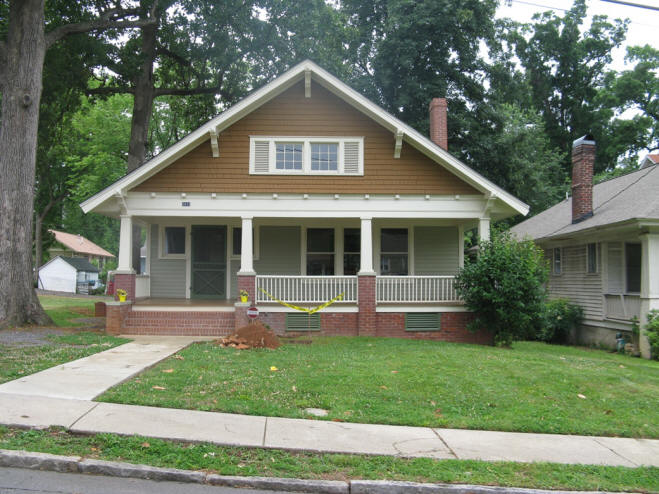
The front elevation is dominated by a substantial front gable that projects over a recessed porch. A rebuilt continuous brick foundation is interrupted by four tall brick piers topped with simple concrete caps. The piers are spaced evenly across the front elevation. Between the easternmost piers, a wide set of brick steps is flanked by cheek walls topped by simple concrete caps. Between the other front piers, the foundation is pierced by large wood louvered vents. A wooden floor with a simple wood band is supported by the masonry porch foundation. The tall piers are connected by balustrades composed of original chamfered top rails and simple original narrow balusters.
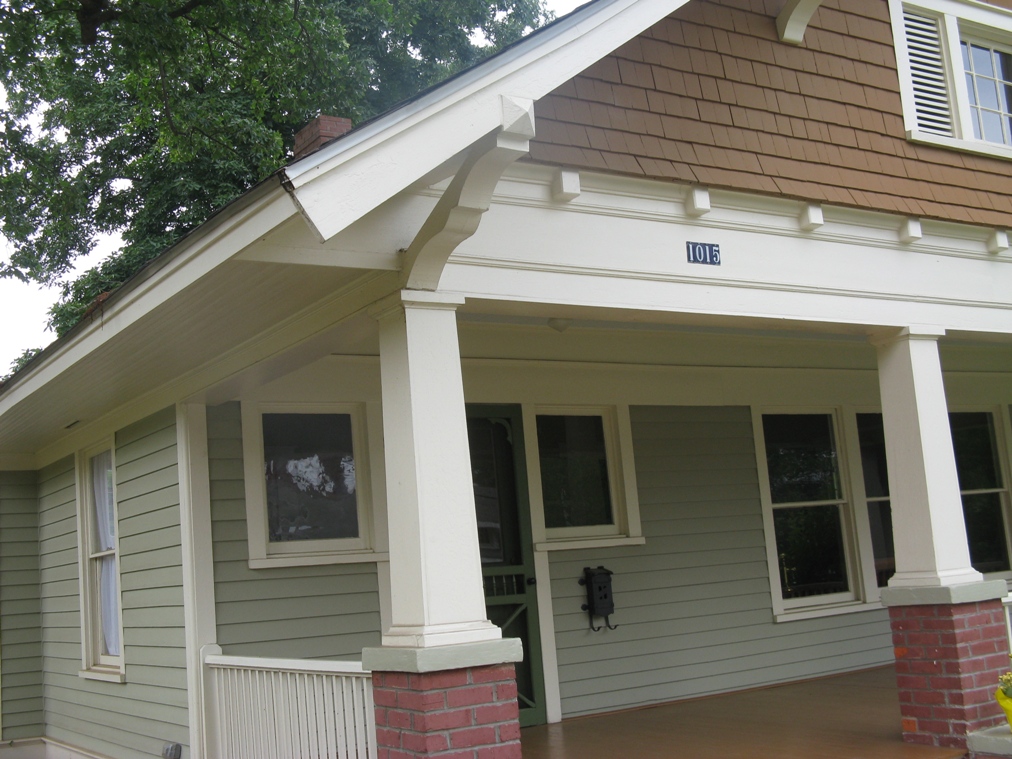
The piers are topped by Craftsman Style tapered posts. The posts rest on simple wooden bases with cavetto trim. The posts are topped with simple wooden caps with cavetto trim. The posts support a boxed beam with a narrow band of cyma recta moulded trim. Above the boxed beam are a row of simple modillions bordered on the bottom by cyma trim. The modillions are separated by deep cyma trim. The modillions and trim project slightly forming a shallow pent. The gable is covered with wood shingles that angle out to cover the pent, giving the gable wall a bell-cast shape.

The gable is pierced by a window opening that contains a pair of fixed nine-light sash bordered on each side by louvered vents. The gable is sheltered by a deep roof overhang supported by decoratively sawn brackets. The soffit is sheathed with beaded boards. Although compromised over the years as roof sheathing has been replaced, the original profile of the gable included a bell-cast design over the eaves.
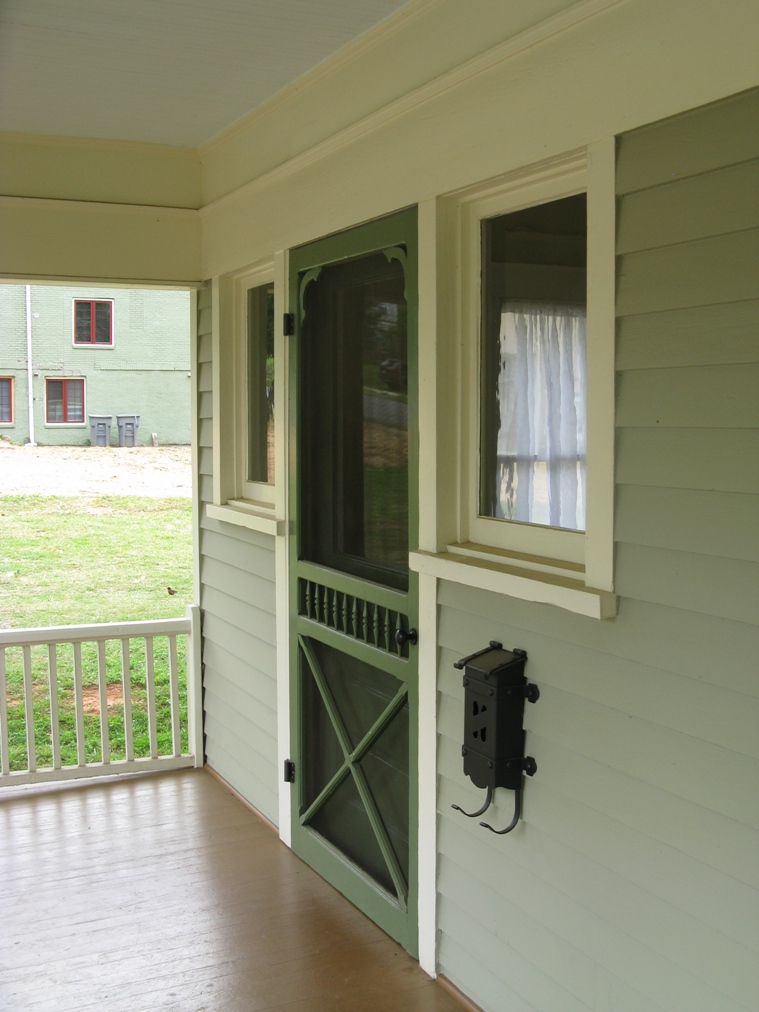
Sheltered by the deep overhangs, all of the architectural elements of the front porch, with the exception of the wood flooring, have survived intact. The porch elevation contains two bays. The east bay contains a wide single-light door. The door also features two horizontal raised panels. The door opening features an early, if not original, screen door. The door is bordered on each side by fixed single-light windows. The relatively short windows are set flush with the top of the door. The other bay contains a set of three one-over-one windows. The original windows feature simple trim and sills. The porch features simple clapboards used on all of the exterior walls. The courses of clapboards terminate in corner boards with a moulded round-over detail. The clapboards on the porch are topped by two-wide wide frieze boards. The horizontal joint between the boards is covered by narrow cyma trim. The porch wall is topped with more narrow cyma trim. The porch ceiling is beaded board.
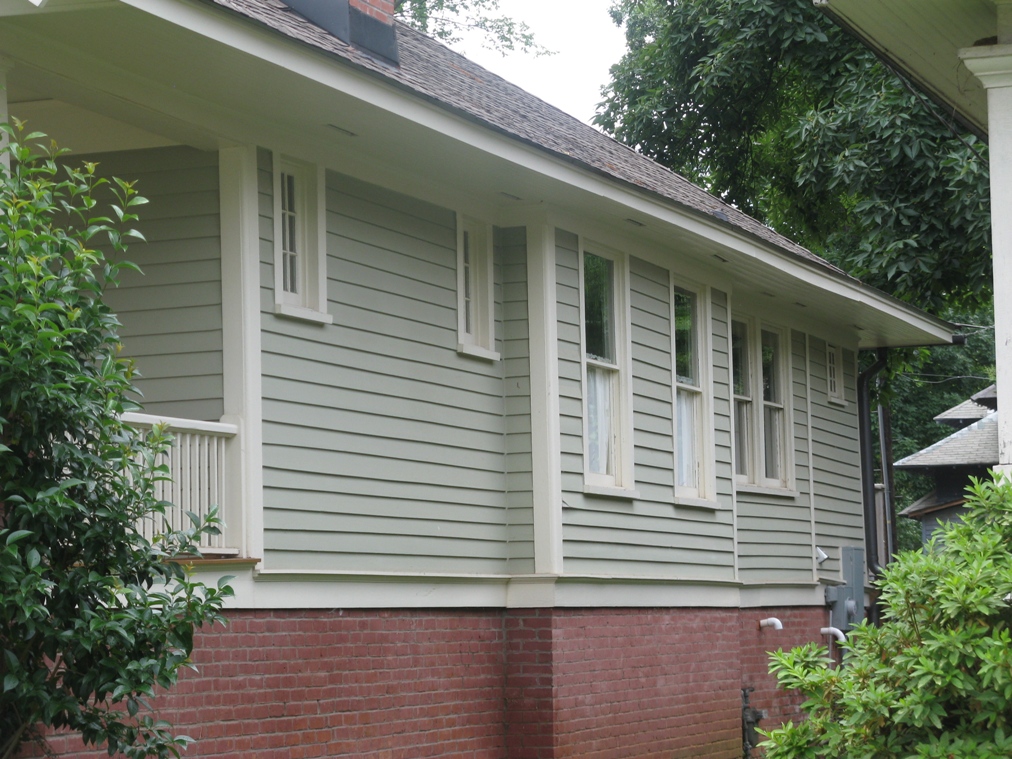
The west elevation contains six window openings. From the front, the first two bays are small nine-light fixed sash set high in the wall. These windows border an interior fireplace, and this design element was common in Craftsman Style houses. A simple bay roughly centered on the west elevation projects slightly and contains two tall one-over-one windows. The projecting bay features corner boards. To the rear of the projecting bay, two one-over-one windows are ganged together. The rearmost section of the west elevation appears to be a rear porch that has been enclosed. On this section the drip cap angles down to the rear, indicating a sloping porch floor. A single small nine-light window is set high in the wall, and may have been moved there from another location on the house. The clapboards on the east, west and rear elevations rise from a drip cap that rests on a simple water table board. The eaves on the east, west and rear elevations feature a beaded-board soffit, now retrofitted with small vents.

While 1015 exhibits a very high overall degree of integrity, the rear is the most altered elevation. Original fenestration is limited to a single small nine-light window set high in the wall. To the east of the original window, a modern wooden double-door has been added. The rear wall of the enclosed porch features a modern wooden glazed panel door. A large recent wooden deck with an integrated accessible ramp extends from the rear elevation. The rear elevation is topped with a hipped roof. The bell-cast element is more distinct on the rear sections of the roof. The roof is pierced by three thin and simply corbelled internal chimneys, all of which have been rebuilt to some extent. Though rebuilt, they match the style and scale of the chimneys on the neighboring houses.
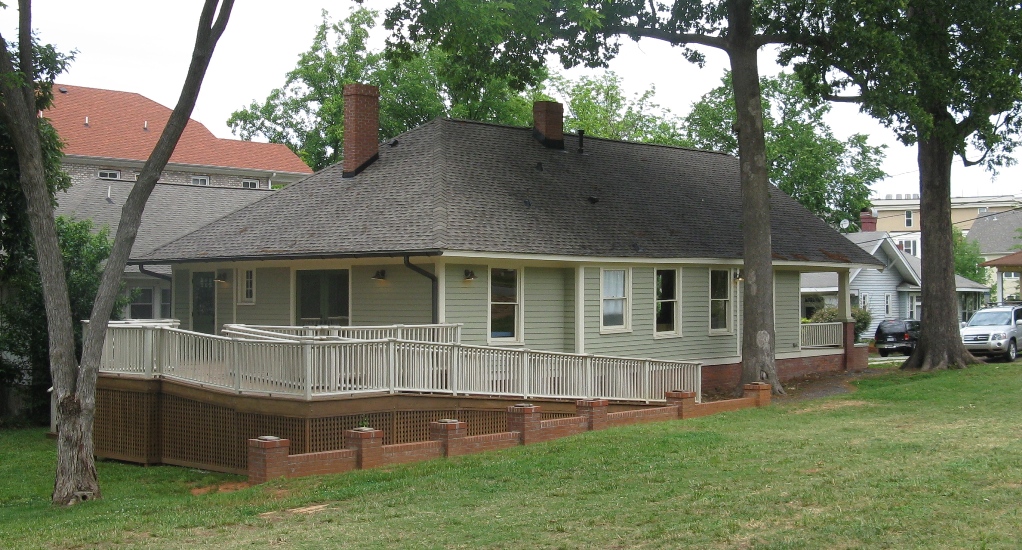
The east elevation features a shallow projecting bay containing three one-over-one windows. The rearmost is slightly shorter than the others on the elevation, but appears to be original. To the rear and to the front of the projecting bay the east elevation is pierced by single one-over-one windows.
Interior
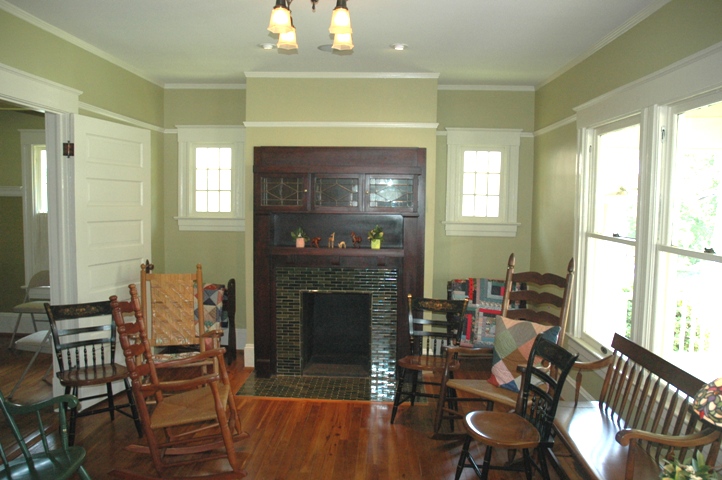
The interior of 1015 West Fourth Street is remarkably well preserved. The interior has retained an exemplary degree of integrity and is in good condition. The ca. 1905 layout of the interior remains virtually intact. All of the original significant interior architectural features have survived intact, and no significant interior alterations have occurred. 1015 West Fourth Street may very well contain the most complete and best preserved Craftsman Style home interior in the City of Charlotte.
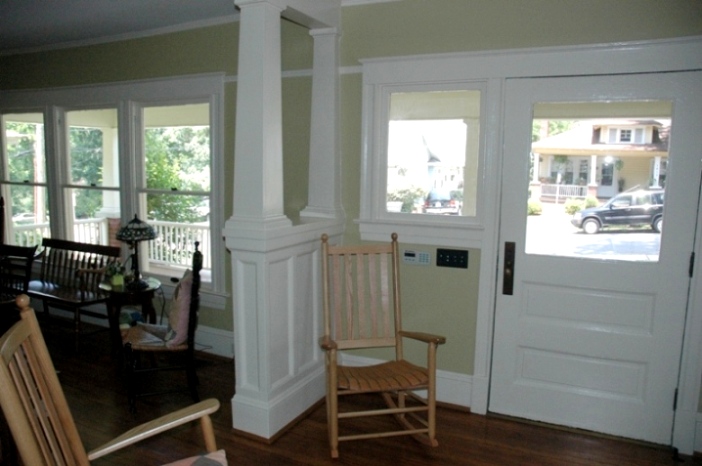
The interior of 1015 features a foyer separated from a front living room by portions of a wood panel half-height wall topped with tapered post and pilasters. The living room features a stained oak mantle surround that incorporates a three-door stained glass cabinet and a recessed mantle shelf supported by modillion brackets. The firebox surround and hearth are covered with original green glazed tile. The living room and foyer feature picture molding. All of the original rooms feature plaster walls and ceilings, narrow-board pine floors, tall baseboards with a molded cap, and molded crown trim. All windows and doors are bordered by fluted jam trim, and feature moulded casing caps. Door trim features starter blocks. The living room, foyer, and the house’s two bedrooms all feature picture moulding.
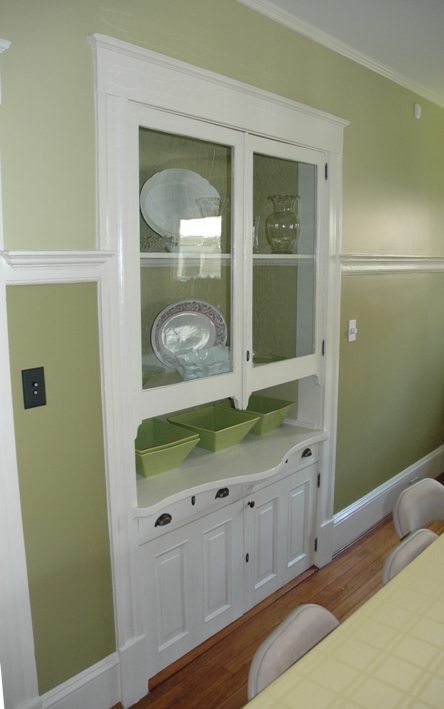
The dinning room is accessed from the living via a pair of six-horizontal-panel doors. The house features numerous built-in cabinets. The largest is a built-in china cabinet in the dining room. It features a curved-sawn shelf, two raised panel doors and two glazed doors, and two drawers with original pulls. The cabinet is border by the same trim used around the doors. The dining room also features a plate rail that runs the perimeter of the room.
The two bedrooms feature six panel doors with original hardware.
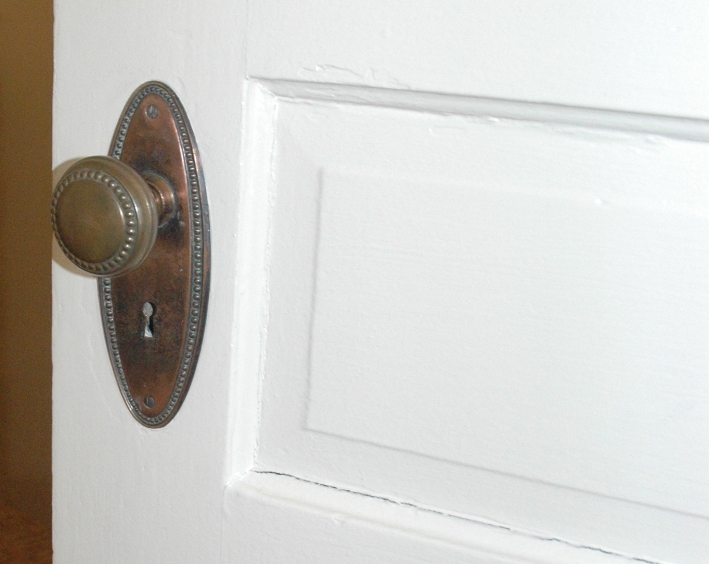
The integrity found in the front, more public rooms is also found in the house’s secondary spaces. The bathroom features the original sink, bathtub, and medicine cabinet. The original tile floor was replace with a tile floor of the same design. The toilet was replace with a modern toilet.
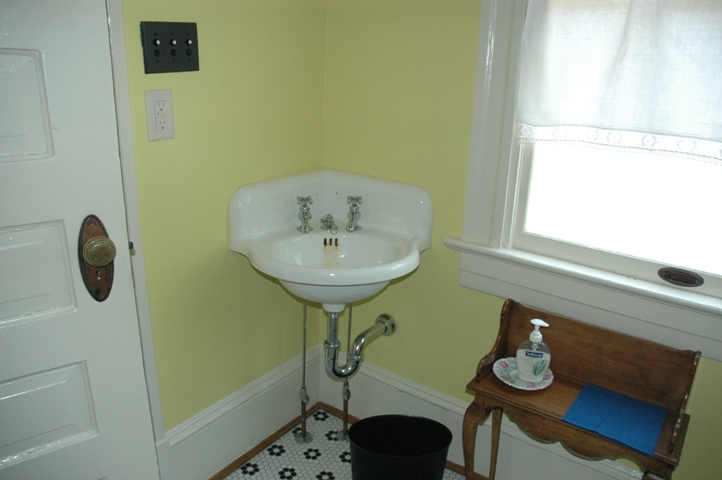
In the kitchen the original pine floor has been preserved. The room features a short six-horizontal-panel pantry door, and two large built-in cabinets with glazed doors. The cabinets are located over the original sink, which is supported by a new cabinet base, and is surrounded by a new tile surround.
The rear hall features the same sophisticated trim found in the other rooms. A recessed fuse box is covered by a panel door, and features the same trim installed around windows. Below the fuse box is short door with a grill.
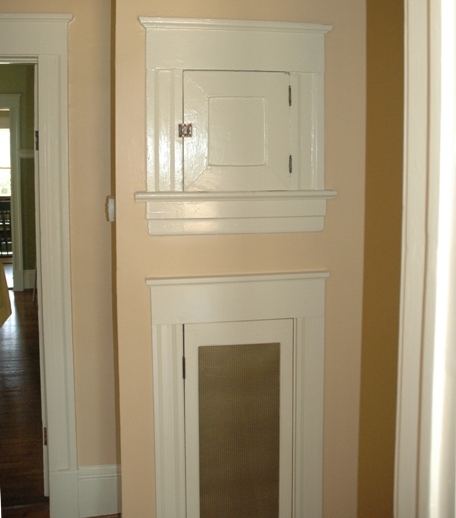
The enclosed rear porch features clapboard siding on the walls. The flooring of the enclosed porch is a collection of various width pine and oak boards.
